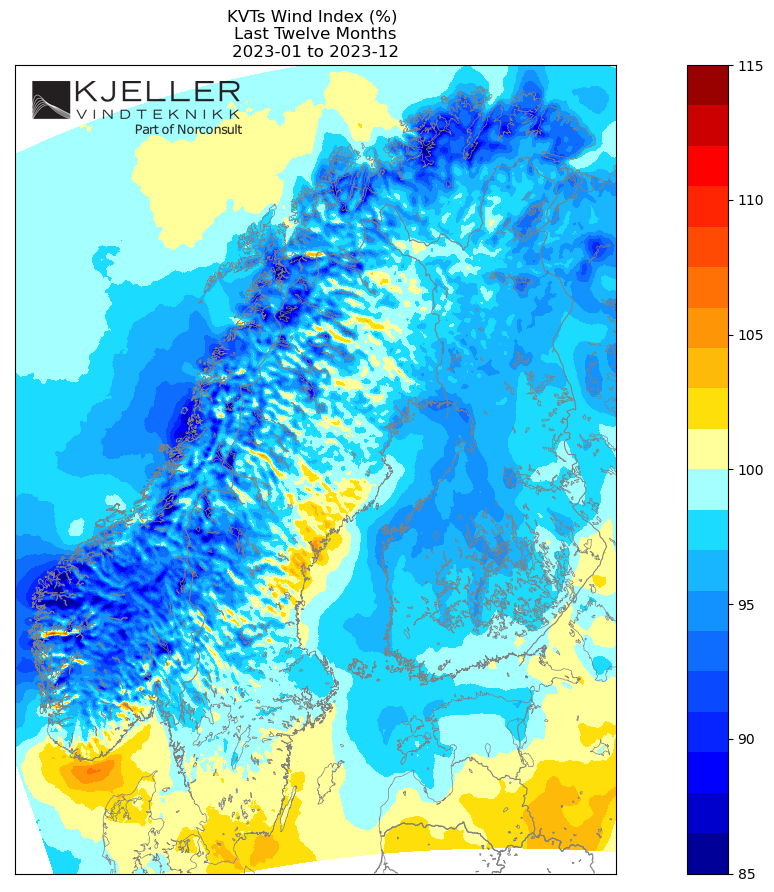“Calm and cold” was the best describing keywords for the three first weeks of the new year over the Nordics. Looking back on the year behind us, the wind has also been remarkably calm over large areas over long periods. Here is a short summary of the wind conditions and other weather curiosities in 2023:
2023 is actually the weakest wind year since KVT introduced the “KVT wind index” in 2019. It was also confirmed in January by the Copernicus Climate Change Service that the 2023 was the hottest year on global average . Paradoxically, 2023 turned out to be a cold year in the Nordics. Except for the two first winter months and June and September, large parts of the region had temperatures below the climatological mean of the 1991-2020 period.
In weather terms, 2023 started with a Nordic divided into two. Due to a persistent high pressure in the east, moderate southerly winds entered Finland, while Southern Norway had calm winter weather. There were some more action in February, where the storm “Otto” (named by the Danish) arrived from the west on the 17th, causing strong winds to Southeastern Norway and later on in Mid Sweden when “Otto” traveled northwards. Being squeezed between a strong high pressure to the south and a low pressure to the north, Northern Sweden and Finland had temporarily quite strong winds.
Turning into spring, the Nordic air turned quiet for a long period due to a slowdown of storm activity triggered by a collapse of the polar vortex in the stratosphere. A strong high pressure for most of April kept the low pressures far away.
May continued with high pressure, but the idyll was interrupted on the Norwegian national day (17th), when strong northerly winds hit Southern Norway. Northern Nordics had some occurrences of low pressures from the west, contributing to strong winds in the last week of May. These strong winds, in combination with high solar production on the continent and snow melting in the Nordics, caused the negative daytime spot prices over large part of Western Europe.

Wind index for the 12-month period 2023-01 to 2023-12.
The only common characteristics for the three summer months was calm wind conditions (with the exception of the southernmost Sweden in July). While June was warm and dry, the rest of the summer of 2023 was not what people usually refer to as nice summer weather. Temperatures were low and parts of Norway and Sweden had heavy precipitation amounts caused by the extreme weather “Hans”. The market’s expected energy prices for the upcoming months fell significantly due to the increased hydro power supply caused by this event alone.
Like the summer season, the autumn started with long periods with high pressure, but sometimes interrupted by low pressures hitting the North Norwegian coast. The storms were not particularly strong, but pressure gradient were increased over Scandinavia, contributing to weak positive wind index anomalies over larger areas.
October marked the start of a remarkably long period with Scandinavian cold (and calm) anomalies and the same weather pattern was acting until recently. But the atmosphere was ready when there was one chance to interrupt, and “Babet” (named by the British) was pushed into Southern Nordics, producing strong wind and water levels in Southern Sweden.
Here follows brief considerations of the wind year of 2023 on a national level:
Norway
For the generation of wind energy in Norway, we assume a lower energy output than for 2022. The wind turbines are mostly located along the coast, with clusters in south-west, west, and middle of Norway. On a yearly average, they all experienced lower wind speeds than a normal year. At the start of the year, the wind speeds were higher than average, with a high fluctuation after Q1. In 2023, we had no new big wind farms in Norway, so the change in production will be caused mainly by the change in wind speed.
Sweden
The wind index was above 100% along the northwestern coast of the Gulf of Bothnia and in the south of Sweden, while the wind index in the rest of the country was below 100%. The southern part of the Norrland region–where a large share of Sweden’s operational and planned onshore wind power is located–experienced slightly above normal wind energy in 7 out of 12 months of the 2023 owing to the stronger regional pressure gradients and cold season storms, while southern Sweden was impacted by sporadic storms throughout the year.
Finland
The wind index was below 100 % almost everywhere in Finland for 2023 and this means below long-term average wind energy production for the year. In 8 months out of 12, the wind index was below 100 % for the Finnish wind fleet which is mostly situated in Ostrobothnia area near the Gulf of Bothnia.
We have recently been focusing on the cold weather this winter. The weather pattern has now changed, bringing stronger winds and higher temperatures into our countries. The future will tell us how the KVT wind index turns out in 2024. In the meanwhile, enjoy the winter and we wish you a happy 2024 with high wind hopes!
